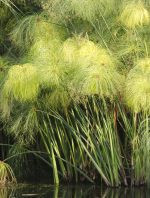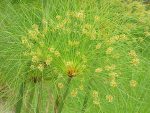
Also known as paper reed and Nile grass, this tender aquatic herbaceous perennial is native to lakes, rivers and swamps of northern Africa, and was cultivated in the Nile Delta in ancient times. It is a member of the sedge family, Cyperaceae, that also includes water chestnut and nutgrass, a common lawn weed. The plants are up to 16′ tall and form grass-like clumps. They have thick woody rhizomes that are covered by red-brown triangular scales when young. Triangular green stems support dense umbels up to 12″ across of thin bright green thread-like structures up to 10″ long. Greenish-brown flower clusters appear at the ends of the threads and give way to brown, nut-like fruits. Photo Credit Wikipedia

Papyrus/bulrush has a long history of use going back to the ancient Egyptians who made one of the first kinds of paper with the stems. Parts of the plant are edible and the stems are very buoyant so can be made into boats. Translators vary on how they chose to render the meaning of the Hebrew words that probably refer to bulrush. Some of the alternatives include papyrus, rush, flag, catail, sedge, grass, water plant, and weed.
Exodus 2. (KJV) Jochebed prepares to hide baby Moses at the edge of the Nile.
3“And when she could not longer hide him, she took for him an ark of bulrushes, and daubed it with slime and with pitch, and put the child therein; and she laid it in the flags by the river’s brink.
Isaiah 18.2 (KJV) The prophet addresses the Ethiopians who send messengers to to make an alliance with Judah and the other nations of the region against Assyria.
“That sendeth ambassadors by the sea, even in vessels of bulrushes upon the waters, saying, Go, ye swift messengers, to a nation scattered and peeled, to a people terrible from their beginning hitherto; a nation meted out and trodden down, whose land the rivers have spoiled!”
Isaiah 19.6 (RHE) The prophet warns Egyptians about what will happen when God strikes.
“And the rivers shall fail: the streams of the banks shall be diminished, and be dried up. The reed and the bulrush shall wither away.”
Isaiah 35.7 (RHE) The prophet gives a message of hope that the land will return to its orginal condition.
“And that which was dry land, shall become a pool, and the thirsty land springs of water. In the dens where dragons dwelt before, shall rise up the verdure of the reed and the bulrush.”
Isaiah 58.5 (KJV) The prophet warns about empty ritual without spiritual substance.
Is it such a fast that I have chosen? a day for a man to afflict his soul? is it to bow down his head as a bulrush, and to spread sackcloth and ashes under him? wilt thou call this a fast, and an acceptable day to the LORD?”
Papyrus likes wet, boggy, shallow standing wter in full sun to paritial shade and is hardy in USDA zones 9-11. It has no significant pests or diseases and is propagated by division. Often used as a house plant and as an ornmental in water gardens, it can become invasive and may need containment.
The genus name, Cyperus, is from the Greek word kypeiros , the name given to sedges in ancient times. The specific epithet, papyrus, comes from the Greek word πάπυρος, referring to paper made into rolls.
Photo Credit: Wikipedia